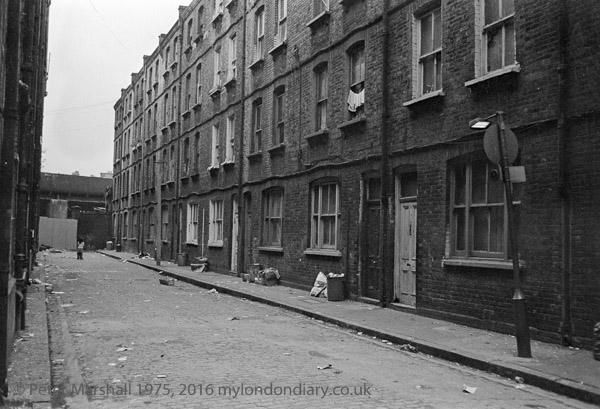London 1978
Peter MARSHALL

Sheba St, off Quaker St, Shoreditch, 1978
17h32: shop, Tower Hamlets
You can click on the image to go to the next picture
Taken somewhere near Brick Lane,
this is a short stretch of road ending at the railway line into Liverpool St.
It no longer exists but I am fairly sure that this was the section of Grey Eagle
St to the north of Quaker St, where there is now a gate leading to Eagle Works,
or possibly Sheba St. The buildings on both sides of the street have now gone.
It was a pity that my black and white pictures did not include the two buildings on the corners of Quaker St and Grey Eagle St, the Grey Eagle Pub and Leons, though I think I photographed one or both in colour. But in 1978 I was still working on colour transparency and never managed to develop a reliable filing system.
As well as Grey Eagle St there is also a Black Eagle St (now Dray Walk) not far away. At the end of the 16th century the area belonged to a goldsmith, Richard Hanbury, who leased part to brickmaker Edward Hemmynge, perhaps the source of Brick Lane, though there were other later brickworks in the area. Quaker St was laid out around 1656 by William Browne who had leased three acres of pasture. Hanbury's daughter married Sir Richard Wheler (hence Wheler St) whose family retained much of the area, leasing parts out. Both Grey Eagle St and Black Eagle St were developed by one of the lessees, John Stott, a mariner from Stepney around 1661-70, and in 1666 the Black Eagle Brewery was built, possibly by London entrepreneur William Bucknall on land leased from Stott. Some sources say the Brewery name came from the strret name, but its origin is unclear.
Around 1679 the brewery with its eagle trademark was acquired by Joseph Truman who had learnt the trade there (though the family records say a family member, William Truman, a brewer, attacked the Lord Mayor of London during Wat Tylers 1381 revolt) and slowly began to grow into a huge concern. Under one of his younger sons, Benjamin Truman, it became the third biggest brewery in London. In 1789 the young Quaker businessman Sampson Hanbury purchased a share in the brewery and gradually bought more, taking over the running of what with the company becoming Truman and Hanbury. Some years after Hanbury's nephew Thomas Fowell Buxton became a partner the company became Truman, Hanbury, Buxton and Company. Buxton was a partner with William Wilberforce in the Anti-Slavery Society founded in 1823.
Another brewer, Thomas Pryor joined the company in 1816, and the business was run by the three brewing families, Hanbury, Buxton and Pryor until the 1950s, becoming the largest brewery in London, outproducing Barclay Perkins, around 1850. The company was the subject of a bitter takeover battle between Watney's and Grand Met in 1971. Grand Met won and the following year rubbed salt into the wound by taking over Watney's. In 1989 Grand Met, who had failed to keep up with the changes in beer consumption towards real ales, realised that the London property boom made the site more valuable than a not too profitable brewery and closed it. But the property bubble burst, and in 1995 the 10 acre site was sold to the Zeloof partnership, who reopened Black Eagle St as Dray Walk and The Old Truman Brewery as a venue for events of various kinds.
[Thanks To Martyn Cornell's Zythophile beer blog for much of the brewery information in a highly detailed article about the Truman Black Eagle Brewery.
]